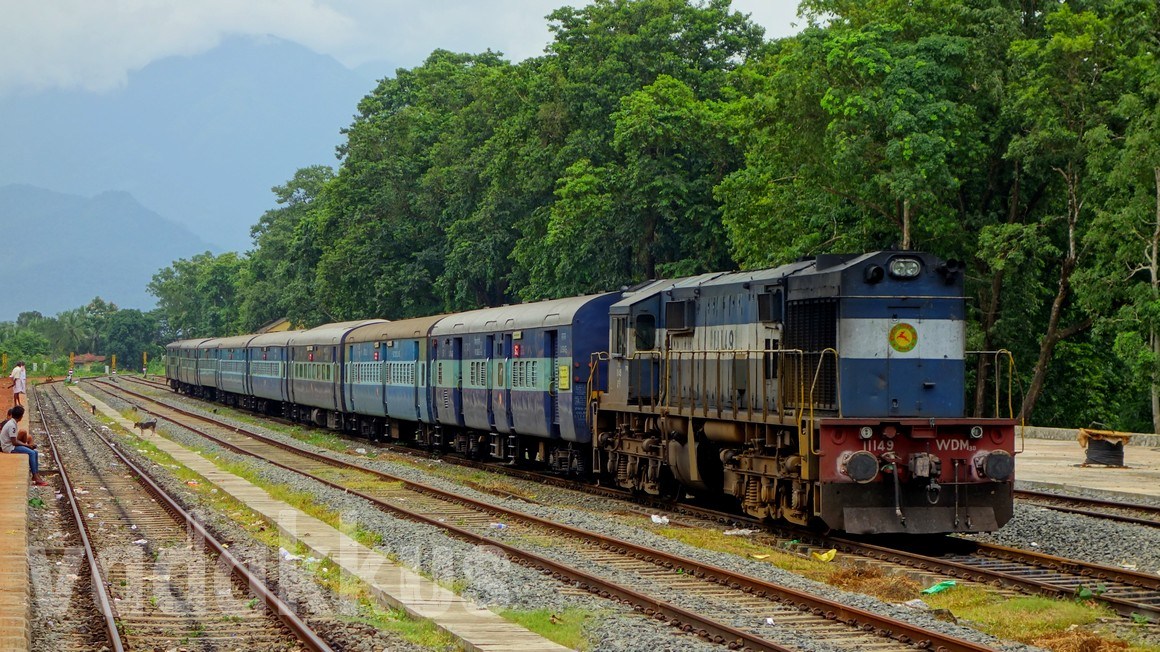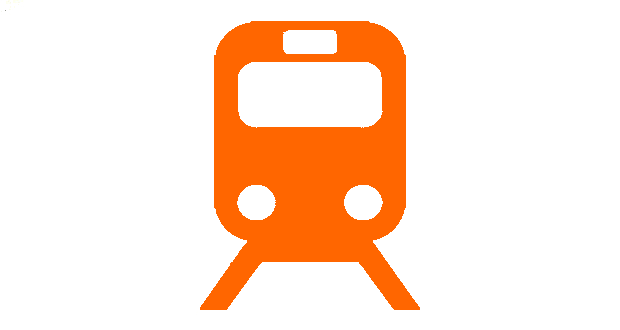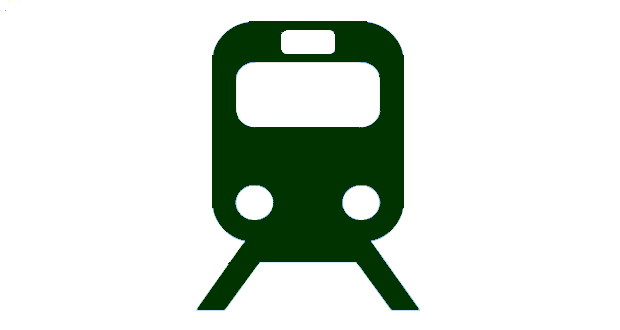The State of the Railways in Kerala: New Railway Lines

No new railway line was constructed in Kerala for the past 25 years. This one fact lies at the reality of Kerala having the least per-capita railway line in India and in extension to the foundation of the overworked and overutilised railway infrastructure in the state. Though doubling existing lines does help in augmenting existing infrastructure, new railway lines need to be constructed to really increase railway infrastructure. There were some new railway lines announced over the past three decades to enhance connectivity within the state and with its neighbours, but none of these have reached anywhere, due to a combination of neglect by various central and state governments and the railway administration. This chapter take a look at those various new railway lines and their present status.
The Sabari Railway Project
The Sabari Rail project is the biggest “new” railway project that Kerala had been hearing of for in the last 30 years. As its name suggests, the project is intended to connect the foothills of the Sabarimala shrine directly by a railway line. The idea was first conceived back in the early 1990s, was officially sanctioned by the Indian Railways in 1998, work started in 2008 and in 2018 all of seven kilometres have been built. The project was marred by all kinds of problems right from the beginning. The terminus of the line was changed from Pampa to Llaha to Azhutha and now to Erumeli. The route and alignment were changed several times, the final alignment has not even been finalised yet. As always, the biggest hurdle has been land acquisition. Locals are up in arms to protect their lands against the evil railway as it is the case everywhere else. The second hurdle is the availability of funds, of which none have been allocated to the project for over a decade and a measly 220 crore was allocated in 2017. As of now, around Rs.2000 crore will be required for land acquisition alone, which is more than the entire allocation to the entire state for the past two years. As of now, the central and state government are tussling over revenue sharing agreements. All this still after the project is supposedly being “directly monitored” by the Prime Minister’s office.
The initial plan was to run the line from Angamali, north of Ernakulam, directly to Pampa via Muvattupuzha, Thodupuzha, Pala and Kanjirappally through the interiors of the Ernakulam, Idukki, Kottayam and Pathanamthitta districts. The idea has now expanded to extend the line further south to Nemom near Trivandrum via Pathanamthitta, Ranni, Punalur, Anchal and Nedumangad. The Sabari railway project will hence help not just to connect the Shrine and relieve the Pambavasan of all the vehicle exhausts polluting his pristine forests but will also create a new railway corridor from Thrissur to Trivandrum through the hills and valleys of central Travancore along the foothills of the Western Ghats. In fact, the Sabari railway should be constructed as a double-track line from the outset so it can be converted into a major commuter corridor with short “private trains” (MEMUs) running shuttle services between these towns.
It is funny to think that they are now planning an airport around Erumeli (Cheruvalli estate). And, of course, there has been absolutely no opposition to this. In fact, everyone only seems to be encouraging it, because airports are sexy while railways are old tech. The last thing Kerala needs is another airport. The government should stop doling out goodies to central Travancore NRI tourists who come holidaying from Australia, Canada, Europe or USA once every three years while ignoring the needs of people who are actually living in the state.
Current status: 7 kilometres of line built from Angamali to Kalady; 80% of land acquisition pending. Final alignment not published.
The Guruvayur-Tirunnavaya line
The newest line ever opened in Kerala was between Thrissur and Guruvayur way back in 1994. It was only the first phase of a 51-km Thrissur-Kuttipuram railway line, intended to connect the shrine of Guruvayur with the rest of the country and also to provide a bypass line for the crowded Shoranur area. The second phase between Guruvayur and Kuttipuram has been pending ever since, for almost 20 years now thanks to fierce local opposition against the line. The northern end of the line was been changed from Kuttipuram to Tirur to Tanur to Tirunnavaya over the years as people rose up in protest against the very idea of acquiring lands for a railway line. The line would’ve been extremely useful by allowing (especially freight) trains to skip Shoranur and save time, to run many trains from the north directly through Guruvayur and connect a lot of highly populated areas in the region and can later be extended southwards along the coast to Edappally or Ernakulam to create a commuter corridor for the coastal regions.
Chengannur-Kottarakara/Punalur-Thiruvananthapuram: There was once a survey conducted for this line, and God only knows what happened to it. The Punalur-Thiruvananthapuram line is said to be part of the Sabari Rail extension (Phase 3). This line would run parallel to the MC Road and relieve it of traffic to some extent.
Cross-Western Ghat Railway Lines
The Western Ghats have for the last 65 million years acted as a natural barrier between Kerala and the rest of the Indian subcontinent. Crossing these dense and imposing mountains has been the major challenge in connecting Kerala with the rest of the Indian subcontinent. Four railway lines are being proposed to connect Kerala with its eastern neighbours, three with Mysore and one with Tamil Nadu. Right now there is only one main runk line that connects Kerala eastwards with the rest of the country. No advance on any of these lines have been forthcoming, mainly thanks to “environmental activists” blocking the projects. They seemingly think trains still run on coal but have no problem in building enormous highways so they can drive their cars around. Building, expanding and maintaining roads would entail enormous costs and destroy the biosphere and environment of the ecologically very sensitive Western Ghats. Railways remain the best option to move large numbers of people across the Ghats.
The Nilambur-Nanjangud Line (Wayanad Railway)
The plan here is to extend the Shoranur-Nilambur line northwards through the Wayanad district (currently not connected by railway) and across the Ghats to reach the Karnataka town of Nanjangodu (Nanjangudu) at the edge of the Deccan plateau, from where existing railway lines will take it further to Mysore and Bangalore. This line has been in contention since 1881 but the British could build only a part of it until Nilambur. Several surveys have been conducted the railways and state governments but nothing has come out of any of them. Routes have been proposed by all possible routes in the region via Nadukani, Koora, Gudalur, etc but all were found unfeasible. As a latest attempt, Mr. “Metro Man” E. Sreedharan undertook a satellite topographical survey at his own initiative and fixed an 148-km alignment of Nilambur – Pothukaal – Mechaal – Kalpetta – Meenangadi – Sulthan Bathery – Sargur – Hullahalli – Nanjangud. There has been no progress since and the project plan has returned to cold storage.
It cannot be emphasised enough how enormously beneficial this line will be for the Mysore and north-central Kerala regions which share deep historical ties. The line will connect all of southern Kerala and Wayanad in a straight line directly to Mysore, significantly changing economies and livelihoods. Goods and people can be transported easily and faster between the two states. Currently around 1000 trucks ply through this route every day Bangalore and Mysore will gain direct access to the Kochi/Vallarpadam ports. It will significantly improve development chances for Chamarajanagara and Wayanad districts and will also give the towns of Kalpetta and Sulthan Bathery fast access to Kerala’s large cities. This railway line will cut the Kalpetta – Ernakulam travel time to around 5 hours from the present 8 hours by road. In addition, it will reduce the Ernakulam-Mysore rail distance to just 342 km from 867 km (6 hours) and the Ernakulam-Bangalore distance to 527 km from 596 km (9 hours) as per the latest survey. The line should be constructed as a fully electrified double line from the outset considering future needs.

The difference here compared to all other new railway projects is that the local people actually support it and want the line to be built. It is the authorities who are complacent. The main apparent distractors of the project have been the usual suspects who “derail” all railway projects: the environment mafia who claim that the line will destroy the Bandipur wildlife sanctuary and tiger reserve along with much of the Western Ghats, like they always do. There is a “night time travel ban” for vehicles on the stretch which ironically most people want to be nulled. A solution has been proposed for the line to go underground at the Bandipur Wildlife sanctuary for 11 kilometres so the animals will not be disturbed. However, they are adamant that the line should still not be built. It goes without saying that the railway line will take thousands of cars and trucks off the roads saving the environment rather!
The Thalasserry-Mysore line (via Kodagu)
A railway line connecting Kodagu with the Northern Malabar coast and Mysore was also been under consideration since the time of the British. The project was recently given a green light with an alignment frozen to run via Koothuparamba, Thillankeri, Payam, This line was also one being considered since the time of the British. It has been surveyed and is supposed to start at Thalasserry in Kannur district and to run via Kuthuparamba, Kannur Airport, Thillankeri, Iritti, Paayam, Kaarikottakari, Birunani, Tithimathi, Hunsur and Handanahalli to Mysore. However. the opposition has been deafening from the Kodagu (Coorg) district, with the locals crying hoarse about the “destruction” the line would bring to the ecologically sensitive areas of the district. The very powerful lobbying groups of the district have ensured that the project has been shelved for now. The same forests of the district is jammed with vehicles and trucks. In fact, there is a project underway to four-lane an existing highway in Kodagu, but the same activists are conspicuously silent on this matter. The road will bring about environmental destruction many times over than a railway line, which in reality is the most ecologically-friendly transportation system in the world. Obviously the elitism of the so-called car-driving “activists” will always be to safeguard their own vested interests.
Kanjangad-Kaniyoor Line:
This latest project to cross the Ghats is intended to connect the remotest areas of northern Kerala and Dakshina Kannada district to bring them closer to Mysore, Bangalore and beyond. The survey has been completed and alignment has been fixed but little has moved beyond that phase. This 90-kilometre line will run from Kanjangad on the Mangalore-Shoranur mainline to Kaniyoor on the Hassan-Mangalore line via Panathur, Sullya and Ninthikal. It can reduce the traveling times from Bangalore to Kasargod to around 6-7 hours from the present 12. However, it does not look like it will happen either, thanks to yes, environment activists.
The Ernakulam-Madurai (Munnar) Line
It has been a long-standing dream to directly connect the largest city in Kerala to the second largest in Tamil Nadu. Its route would take this line through Ernakulam’s ever-growing eastern suburbs of Thiruvankulam, Puthencruz and Kolencherry and then through the large towns of Muvattupuzha and Kothamangalam and through the heart of Idukki district’s northern regions past Adimali, Devikulam (12 km from Munnar) and Pooppara, then crossing over through a tunnel to emerge at Bodinaykannur at the foot of the Western Ghats in Tamil Nadu. From there it would join the existing (dismantled for Gauge conversion) line to go on to Madurai via Theni. It would’ve also served as a commuter corridor for suburban trains on the heavily travelled Muvattupuzha-Kolenchery-Ernakulam stretch and crossing the Sabari Rail at Muvattupuzha, making this gateway to the Western Ghats a major railway junction and hub. One could’ve reached Ernakulam from Madurai in under five hours, compared to the present 8 hours by road. This railway line would provide Madurai and Thoothukudi with the shortest route to the nearest western port of Kochi/Vallarpadam in a direct straight line enabling smooth trade and easy transhipment. It would’ve also been a tourist’s dream, a picturesque railway line through the stunning Kerala High Ranges with its mist-clad mountains, deep, green valleys, lakes, dams, and tea estates, and the beautiful landscapes of the Theni district lying in the shadows of the Western Ghats. It would’ve also connected Munnar by rail again, more than a century after the lines there were washed away in the floods of 1924. But of course, nobody is interested, and the project has been dropped.
Gauge Conversions
Recently a total of 64 kilometres of new lines were created by gauge conversion of old metre gauge lines across the ghats. However, no new trains have been introduced on the stretch despite enormous demand and revenue potential. Southern Railway, as usual, ignores any demand coming from Kerala to utilise new lines to run trains.
The Kollam-Shenkotta Line
The Kollam-Shenkotta railway line was the former lifeline and first railway line of the erstwhile Travancore state. The line that includes a number of tunnels, viaducts and the 13-Kannara arch bridge was constructed by the British as a metre-gauge line way back in 1902. Even with limited technology and material, they took just three years to build it through mountains covered with thick, forbidding, uninhabited and unexplored jungle. The line was closed for gauge conversion in 2000. Our heroes of the 21st century, armed with all “modern tools and technology” at their disposal, then took seventeen years to convert the 36-km Meter Gauge line to Broad Gauge! It gets worse. In those ancient times, steam engine trains ran up and down gradients at 60 kph. Today, our “modern” track can support only 30 kph and requires extra locos to push the train up the gradients. Talk about going backwards. And after finishing it, trial runs have resulted in a spate of multiple derailments, landslips and other assorted accidents. After a year of false starts, all this erstwhile prestigious line which had once nearly 10 daily services today sees only one weekly special train (which runs jam packed).
The Palakkad – Pollachi Line
This 28-km railway line, another old-timer famous for starring in several Malayalam and Tamil movies, was opened as Metre Gauge in 1932 and converted to Broad Gauge in 2017. After opening, today there are a grand total of three trains running on this line and all of them being useless. This line has enormous potential to connect Mumbai, Goa, Konkan, Mangalore, Malabar and Travancore with the Palani circuit and the entire southern half of Tamil Nadu: Madurai, Toothukudi, Trichy, Tanjavur, Rameshwaram, Tirunelveli etc. After much clamour from all quarters, Southern Railway half-heartedly ran an Ernakulam-Rameshwaram special train once week on terribly odd timings. Still the train still ran full, but SR hurriedly cancelled the service claiming it was empty! Instead they extended the Amrita Express to Madurai which no one asked to. The wait for a train from Rameshwaram to Mangalore and Ernakulam, both definitive money spinners remain a mirage as they blatantly refuse to run trains on the newly created railway line.
Building these new lines are all well and good, but these are not the real solution to the infrastructural problems with the railways in Kerala. That would be to double the existing railway capacity in the state. In other words, the existing double line has to be doubled. There are a whole lot of reasons for this, and traffic volume is only one of them. The real way for a sustainable future for Kerala is to develop a four-lane railway corridor extending the length of the state to operate a rapid rail transit system on a suburban commuter model. Read on in the next chapter.




